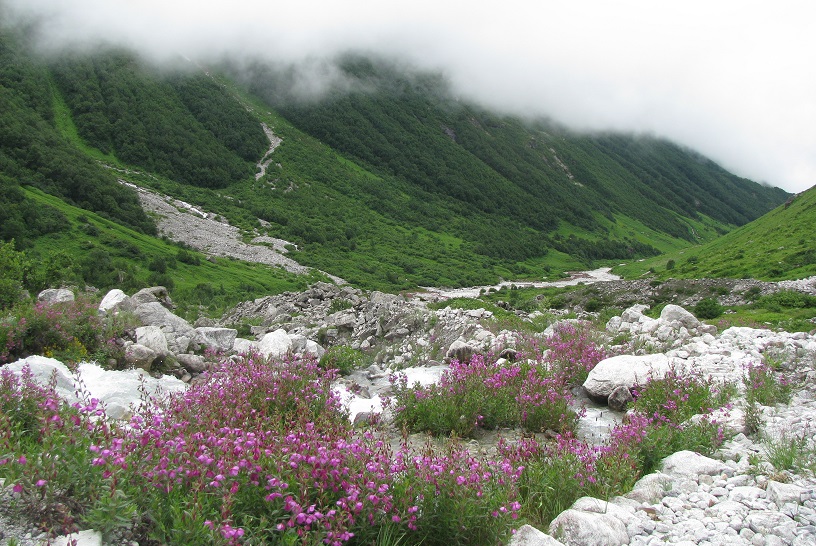
Valley Of Flowers Trek Tour Package 2023: Cheap Budget Standard & Luxury Premium packages and costs at best
Blog | Place To Stay | Place To Eat | Place To Visit | History | EDC | Maps | Photos | Helicopter Tickets | Guide Services | FAQ | What to Carry
Here you will find different Valley of Flowers trek tour packages and cost for 2023 including the Budget/Standard and Premium options.
Is Valley of Flowers Trek difficult?
What is the best time to visit Valley of Flowers?
How long is Valley of Flowers Trek?
How do I plan a trip to Valley of Flowers?
Hotels in Valley Of Flowers |
Guide For Valley of Flowers |
|---|
Valley of Flowers Trek- A beautiful trek in the Nandadevi National Park Himalayas
Duration : 02 Nights / 03 Days
Places Covered : Joshimath - Govindghat - Ghangaria - Valley o
f flowers - Joshimath
Base : Joshimath
Best Time to Visit : End June till Mid September
Nature of Trek : Easy to Moderate Level
Fix Departure Trip @ 6499 per person
Include :: Local Transport, Guide for entire tours, Accommodation 2 nights at Ghangaria with all veg meals.
The Discovery of The Valley of Flowers National Park Uttarakhand India:
It is well known that Valley was discovered in the year 1931, when Frank S. Smythe, a British mountaineer along with his six other British mountaineers lost their way while descending from Mount Kamet East, at 7757metert, situated in Uttarakhand Garhwal Himalayas. Below 17,000 feet there was heavy rainfall and stoarm with dense mist surrounded the east of mountain side. They miss the main route and paused, uncertain to the route. Suddenly his partner R. L. Holdsworth, a botanist as well as a climbing member of the main expedition team exclaimed “Look”, Suddenly Frank S. Smythe followed the direction of his outstretched hand. When they descend down he could see nothing rather then rocks, later suddenly his wandering gaze was arrested by a little row of splash of blue, and beyond it were other splashes of blue, and other varity of flowers in area, he have given the name of valley of flowers, One can encoutner bluish shade of Valley of Flowers especially in July and August month.
Day 1 : Joshimath - Ghangaria (30,48m)
We will pick up you from Hotel in Joshimath and from Joshimath drive to Govindghat, which is the starting point for the trek. From Govindghat there is a gradual ascent along a well - maintained pilgrim trail to the camp at Ghangaria - the base from where day walks can be made into the valley of flowers. Arrange porters and prepare for the trek. After a light breakfast, 14 km trek up to Ghangaria. Dinner & Night halt at Camp / Hotel. ( All meals at camp).
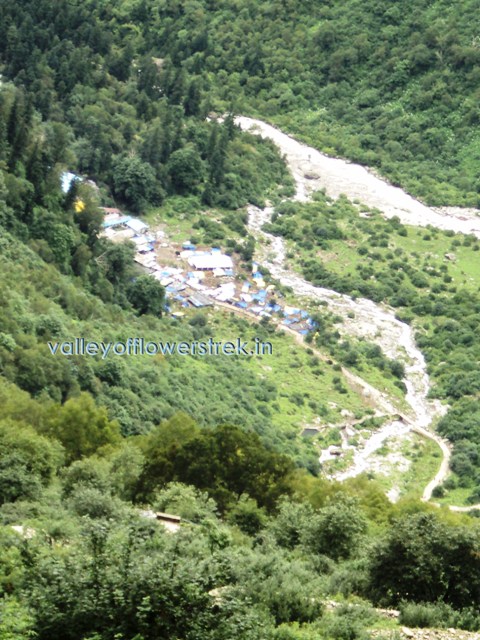
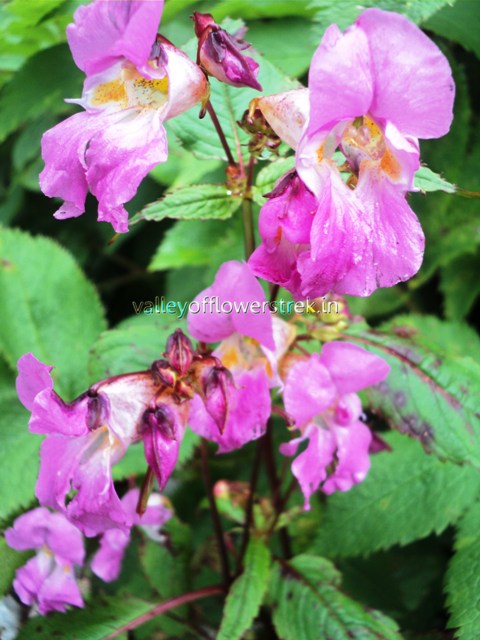
Day 2 : Ghangaria - Valley Of Flowers - Ghangria (3,658~3962m).
After breakfast start trek to valley of flowers. The first part of the trek is through thick forest along the Pushpavati river. Later we trek in the open meadow. Explore various Himalayan flowers inside the parks and back to Ghanghariya. Overnight at Hotel / Lodge. The valley is an enchanting sight with an impressive array of rare wildflowers like brahma kamal, fane Kamal with range of small multicolored flowers make it a delight for travelers. The snowclad peaks including Nilgiri Parbat (6474 m) stand in bold relief against the skyline. The valley is 10 kms long, 2 kms wide, and is divided by the Pushpawati stream, into which several tiny streams and waterfalls merge.
Day 3 : Ghangaria - Joshimath
After breakfast leave for Govindghat on the trek of 14 kms and reach govindghat be afternoon and drive back to Joshimath after that. check in hotel on arrival and relax. One can also visit Auli in the evening. overnight at hotel. ( breakfast and lunch ).
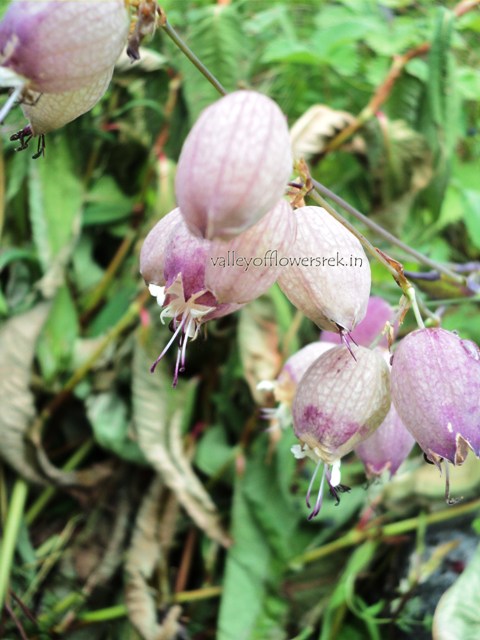
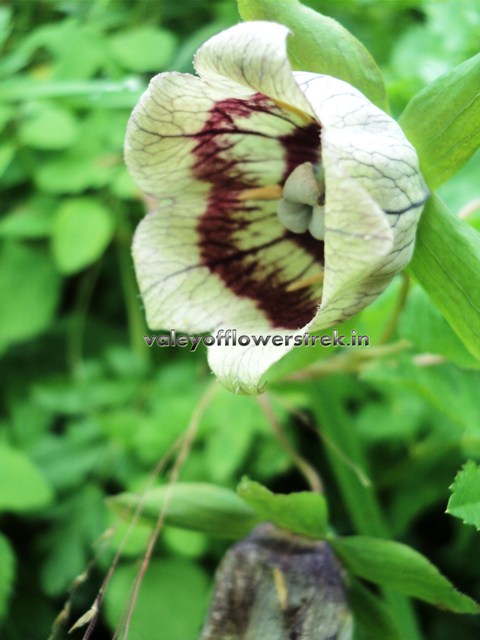
Protection and management requirements
The Nanda Devi and Valley of Flowers National Parks are naturally well protected due to their inaccessibility. The State Forest Department undertakes regular monitoring of the limited routes that provide access to these parks. Both parks are subject to very low levels of human use, with only some community-based ecotourism that is regulated and facilitated by the park management. There has been no livestock grazing inside these parks since 1983. Mountaineering and adventure-based activities inside Nanda Devi National Park has been banned since 1983 due to garbage accumulation and environmental degradation by such activities in the past. The status of flora, fauna and their habitats inside Nanda Devi National Park has been monitored through scientific expeditions carried out once in every ten years since 1993. Results of the surveys and time series analysis of remote sensing data indicate substantial improvement in the status of flora, fauna and their habitats inside Nanda Devi National Park. Similarly, studies and annual surveys in Valley of Flowers National Park indicate the maintenance of the status of the flora, fauna and habitats. Both the National Parks and the Reserved Forests in the buffer zone of the Nanda Devi Biosphere Reserve are well protected and managed as per wildlife management and working plans respectively
The long-term protection of the Nanda Devi and Valley of Flowers National Parks is dependant on the maintenance of the high levels of protection and current low levels of anthropogenic pressures within the parks. Regular monitoring of the status of wildlife and their habitats in these parks is critical and needs to be continued. Tourist or pilgrim management, and development activities such as hydro power projects and infrastructure inside the buffer zone of the Nanda Devi Biosphere Reserve are the existing and potential threats that need to be addressed.
Historical Description
Established as a national park with effect from 6 November 1982 as per Notification No. 3912/14-3-35-80 of 6 September 1982, the intention having been declared under Notification No. 2130/14-3-35-80 of 18 August 1980. Dang (1961) provides an historical account of the exploration of the Handa Devi Basin. The first recorded attempt to enter the sacred basin was by W. W. Graham in 1883, but he was unable to proceed beyond the gorge of the lower Rishi Ganga. Subsequent attempts by Dr T. G. Longstaff in 1870 and Hugh Ruttledge in 1926, 1927 and 1932 also met with failure. Finally, in 1934, Eric shipton and H. W. Tilman pioneered a route to the 'Inner Sanctuary' by forcing a passage up the gorge of the upper Rishi Ganga. Later, in 1936, Tilman and N. E. Odell made the first ascent of Handa Devi, reputedly the most outstanding mountaineering success of the pre-Second World War era. It was their accounts of this natural sanctuary that first drew attention to the spectacular mountain wilderness (Tilman, 1935; Shipton, 1936), following which the area was established as a game sanctuary on 7 January 1939 (Government Order No. 1493/XIV-28). Commonly referred to as 'Handa Devi Sanctuary', the name was changed to sanjay Gandhi National Park at the time of notification. This met with local opposition and the site was gazetted as Handa Devi National Park. The park was inscribed on the World Heritage List in December 1988. The park constitutes the core zone of a much larger area (200,000ha), extending as far north as the Dhauli Ganga, that has been proposed as a biosphere reserve (Indian National MAB Committee, n.d.).
View of Valley of flowers in June end
Our Valley of flowers trek base is Joshimath and we driveto Pulna by car and trek to Ghangaria first. From here we visit Valley Of Flowers trail inside the Valley of Flowers Core Zone and Hemkund Sahib and lake on two different day hikes.
Itinerary for Valley of Flowers tour package:
Day 1: Drive from Rishikesh (by 6 am) to Joshimath – 240 Km – 9 hours. Lodge/Hotel.
Day 2: By car reach Pulna – 30 Km – Trek to Ghangaria – 10 Km – 6/7 hours.
Day 3: Trek to Valley of Flowers and back to Ghangaria – 8 Km – 6/7 hours.
Day 4: Trek to Hemkund Sahib and back to Ghangaria – 12 Km – 7/8 hours.
Day 5: Trek to Pulna – 10 Km – 4/5 hours. Drive to Joshimath – 30 Km. Lodge/Hotel.
Day 6: Drive from Joshimath to Rishikesh/Haridwar – 265/290 Km – 9 hours.
TREK Highlights:
Nearest Rail station: Haridwar (Station Code: HW) or Rishikesh/Yog Nagari Rishikesh (RKSH/YNRK).
Nearest Airport: Delhi; Dehradun (Airport Code: DED). Dehradun airport at Jolly Grant is only 20 Km from Rishikesh and an hour’s drive.
Grade: Easy
Physicality: 5.5/10
Trail Length: 40 Km
Highest Point: Hemkund Sahib~ 4160 m/13650 ft.
Seasons: Late June to late September (Better in July and August during monsoon)
For trek details, photos, flowers and biodiversity, getting there independently and more, read the below link:
| No. of Persons in a group | TREK FEE per person Base to Base |
|---|---|
| 4 | ₹ 12,500 |
| 5 + 6 | ₹ 11,500 |
| 7 + 8 | ₹ 10,500 |
| 8 + 9 | ₹ 10,200 |
| 10 +11 | ₹ 10,000 |
| 12 + 13 | ₹ 09,800 |
| Above 14 | ₹ 09,700 |
We will arrange transportation from Haridwar/Rishikesh to Joshimath and return.
- Tata Sumo: ₹ 8000 one way (Can accommodate 6/7 persons) from Rishikesh.
- Tempo Traveller: ₹ 12,000 one way (can accommodate 10 – 14) from Rishikesh.
| No. of Persons in a group | TREK FEE per person Base to Base |
|---|---|
| 2 + 3 | ₹ 25,000 |
| 4 + 5 | ₹ 21,000 |
| 6 + 8 | ₹ 18,000 |
| 9 + 10 | ₹ 17,000 |
| 11 and more | ₹ 16,000 |
Inclusions and Exclusions:
- We will provide one qualified and local trekking tour guide who will have excelling understanding of the trekking trail and terrain. For groups of 8 or more we will provide 2 such guides.
- We may arrange a specialised flowers guide inside Valley Of Flowers. We can pre book such a guide based on the person’s availability. You may pay directly @ ₹ 3000/day on spot to the guide.
- If you wish to offload your luggage during trek, then we will arrange a horse for the same on spot. You pay directly (₹ 1200-1400 for Govindghat to Ghangaria, one way. It is better to carry rucksack or duffel bag instead trolley bags).
- We will arrange transportation from Haridwar to Govindghat and return, if needed. You pay directly to the driver as per following actual cost:
- Toyota Innova: ₹ 12, 000 one way (Can accommodate up to 5 persons)
- Tempo Traveller: ₹ 12,000 one way (can accommodate 10/12 persons)
Species in Valley of flowers National Park
The species listed below represent a small sample of iconic and/or IUCN Red Listed animals and plants found in the property. World Heritage Properties in which a species has been identified. These species are identified in an effort to better communicate the biological diversity contained within World Heritage properties inscribed under criteria ix and/or x.
- Acer caesium / Himalayan Maple
- Agama tuberculata / High altitude lizard
- Betula utilis / Himalayan Birch
- Cassiope fastigiata / Himalayan Heather
- Geum elatum
- Hemitragus jemlahicus / Himalayan Thar
- Lophophorus impejanus / Himalayan Monal
- Martes flavigula / Himalayan yellow marten
- Moschus leucogaster / Himalayan musk deer
- Mustela sibirica / Himalayan wease
- Panthera uncia / Snow leopard
- Papiliu demoleus / Lime Butterfly
- Petaurista petaurista / Flying squirrel
- Potentilla atrosanguinea
- Presbytis entellus / Common langur
- Rhododendron campanulatum / Bell Rhododendron
- Rubus ellipticus
- Saussurea obvallata / Brahmakamal
- Selenarctos thibetanus / Himalayan black bear
- Trachydium roylei
- Vulpes vulpes
For Further Details and Booking write down us or call us :
Corporate Office![]()
24 HRS contact number : + 91-
09837937948 / 09759675791
/ 09412439693
Email : nandadevitrekking@gmail.com
CHAT RD : MSN : YAHOO : SKYPE : garhwalhimalaya
Visit us: www.valleyofflowerstrek.in / www.nandadevitrek.in
![]()
![]()
![]()
![]()
